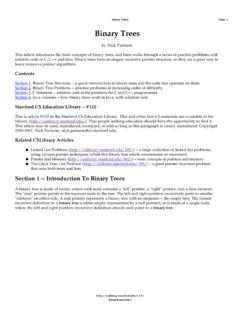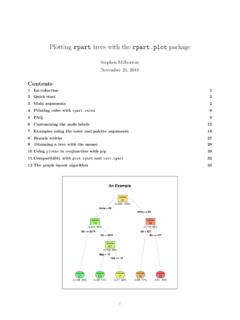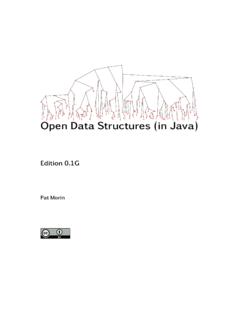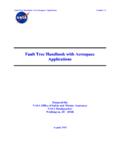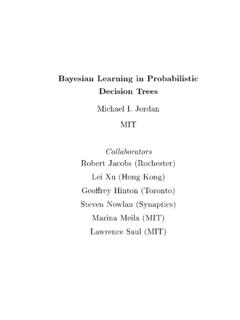Transcription of csci 210: Data Structures Trees - Bowdoin College
1 1csci 210: data StructuresTreesSummary Topics general Trees , definitions and properties interface and implementation tree traversal algorithms depth and height pre-order traversal post-order traversal binary Trees properties interface implementation binary search Trees definition h-n relationship search, insert, delete performance READING: GT textbook chapter 7 and So far we have seen linear Structures linear: before and after relationship lists, vectors, arrays, stacks, queues, etc Non-linear structure : Trees probably the most fundamental structure in computing hierarchical structure Terminology: from family Trees (genealogy)3 Trees store elements hierarchically the top element: root except the root, each element has a parent each element has 0 or more children root4 Trees Definition A tree T is a set of nodes storing elements such that the nodes have a parent-child relationship that satisfies the following if T is not empty, T has a special tree called the root that has no parent each node v of T different than the root has a unique parent node w.
2 Each node with parent w is a child of w Recursive definition T is either empty or consists of a node r (the root) and a possibly empty set of Trees whose roots are the children of r Terminology siblings: two nodes that have the same parent are called siblings internal nodes nodes that have children external nodes or leaves nodes that don t have children ancestors descendants5 Treesrootinternal nodesleaves6 Treesancestors of uu7 Treesudescendants of u8 Application of Trees Applications of Trees class hierarchy in Java file system storing hierarchies in organizations9 tree ADT Whatever the implementation of a tree is, its interface is the following root() size() isEmpty() parent(v) children(v) isInternal(v) isExternal(v) isRoot()10 tree Implementation class tree {TreeNode root; // tree ADT }class TreeNode<Type> {Type data ; int size; TreeNode parent; TreeNode firstChild; TreeNode nextSibling; getParent();getChild(); getNextSibling().}
3 }11 Depth: depth(T, v) is the number of ancestors of v, excluding v itself Recursive formulation if v == root, then depth(v) = 0 else, depth(v) is 1 + depth (parent(v)) Compute the depth of a node v in tree T: int depth(T, v) Algorithm: int depth(T,v) {if (v) return 0return 1 + depth(T, (v))} Analysis: O(number of ancestors) = O(depth_v) in the worst case the path is a linked-list and v is the leaf ==> O(n), where n is the number of nodes in the treeAlgorithms on Trees : Depth12 Height: height of a node v in T is the length of the longest path from v to any leaf Recursive formulation: if v is leaf, then its height is 0 else height(v) = 1 + maximum height of a child of v Definition: the height of a tree is the height of its root Compute the height of tree T: int height(T,v) Height and depth are symmetrical Proposition: the height of a tree T is the maximum depth of one of its leaves.
4 Algorithms on Trees : Height13 Height Algorithm: int height(T,v) {if (v) return 0; int h = 0; for each child w of v in T do h = max(h, height(T, w))return h+1; } Analysis: total time: the sum of times spent at all nodes in all recursive calls the recursion: v calls height(w) recursively on all children w of v height() will eventually be called on every descendant of v overall: height() is called on each node precisely once, because each node has one parent aside from recursion for each node v: go through all children of v O(1 + c_v) where c_v is the number of children of v over all nodes: O(n) + SUM (c_v) each node is child of only one node, so its processed once as a child SUM(c_v) = n - 1 total: O(n), where n is the number of nodes in the tree14 tree traversals A traversal is a systematic way to visit all nodes of T.
5 Pre-order: root, children parent comes before children; overall root first post-order: children, root parent comes after children; overall root lastvoid preorder(T, v)visit vfor each child w of v in T do preorder(w)void postorder(T, v)for each child w of v in T do postorder(w)visit v Analysis: O(n) [same arguments as before]15 Examples tree associated with a document In what order do you read the document? tree associated with an arithmetical expression Write method that evaluates the expression. In what order do you traverse the tree ?+3*-125+1717 Binary trees18 Binary Trees Definition: A binary tree is a tree such that every node has at most 2 children each node is labeled as being either a left chilld or a right child Recursive definition: a binary tree is empty; or it consists of a node (the root) that stores an element a binary tree , called the left subtree of T a binary tree , called the right subtree of T Binary tree interface left(v) right(v) hasLeft(v) hasRight(v) + isInternal(v), is External(v), isRoot(v), size(), isEmpty()19 In a binary tree level 0 has <= 1 node level 1 has <= 2 nodes level 2 has <= 4 nodes.
6 Level i has <= 2^i nodes Proposition: Let T be a binary tree with n nodes and height h. Then h+1 <= n <= 2 h+1 -1 lg(n+1) - 1 <= h <= n-1 Properties of binary treesd=0d=1d=2d=320 Binary tree implementation use a linked-list structure ; each node points to its left and right children ; the tree class stores the root node and the size of the tree implement the following functions: left(v) right(v) hasLeft(v) hasRight(v) isInternal(v) is External(v) isRoot(v) size() isEmpty() also insertLeft(v,e) insertRight(v,e) remove(e) addRoot(e) dataleftrightparentBTreeNode:21 Binary tree operations insertLeft(v,e): create and return a new node w storing element e, add w as the left child of v an error occurs if v already has a left child insertRight(v,e) remove(v): remove node v, replace it with its child, if any, and return the element stored at v an error occurs if v has 2 children addRoot(e): create and return a new node r storing element e and make r the root of the tree .
7 An error occurs if the tree is not empty attach(v,T1, T2): attach T1 and T2 respectively as the left and right subtrees of the external node v an error occurs if v is not external22 Performance all O(1) left(v) right(v) hasLeft(v) hasRight(v) isInternal(v) is External(v) isRoot(v) size() isEmpty() addRoot(e) insertLeft(v,e) insertRight(v,e) remove(e)23 Binary tree traversals Binary tree computations often involve traversals pre-order: root left right post-order: left right root additional traversal for binary Trees in-order: left root right visit the nodes from left to right Exercise: write methods to implement each traversal on binary trees24 Application: tree drawing Come up with a solution to draw a binary tree in the following way. Essentially, we need to assign coordinate x and y to each node. node v in the tree x(v) = ?
8 Y(v) = ? 012301234456725 Application: tree drawing We can use an in-order traversal and assign coordinate x and y of each node in the following way: x(v) is the number of nodes visited before v in the in-order traversal of v y(v) is the depth of v012301234456726 Binary tree searching write search(v, k) search for element k in the subtree rooted at v return the node that contains k return null if not found performance ?27 Binary Search Trees (BST) Motivation: want a structure that can search fast arrays: search fast, updates slow linked lists: search slow, updates fast Intuition: tree combines the advantages of arrays and linked lists Definition: a BST is a binary tree with the following search property for any node vallows to search efficientlyvT1T2kall nodes in T1<= kall node in T2 > k28 BST ExamplevT1T2k<= k> k29 Sorting a BST Print the elements in the BST in sorted order30 Sorting a BST Print the elements in the BST in sorted order.
9 In-order traversal: left -node-right Analysis: O(n)//print the elements in tree of v in ordersort(BSTNode v)if (v == null) return; sort( ());print (); sort( ()); 31 Searching in a BST32 Searching in a BST//return the node w such that () == k or null if such a node //does not existBSTNode search (v, k) {if (v == null) return null; if ( () == k) return v;if (k < ()) return search( (), k);else return search( (), k)} Analysis: search traverses (only) a path down from the root does NOT traverse the entire tree O(depth of result node) = O(h), where h is the height of the tree33 Inserting in a BST insert 2534 Inserting in a BST insert 25 There is only one place where 25 can go //create and insert node with key k in the right place void insert (v, k) {//this can only happen if inserting in an empty treeif (v == null) return new BSTNode(k); if (k <= ()) { if ( () == null) { //insert node as left child of vu = new BSTNode(k); (u); } else { return insert( (), k);}} else //if ( () > k) {.}}
10 }}2535 Inserting in a BST Analysis: similar with searching traverses a path from the root to the inserted node O(depth of inserted node) this is O(h), where h is the height of the tree36 Deleting in a BST delete 87 delete 21 delete 90 case 1: delete a leaf x if x is left of its parent, set parent(x).left = null else set parent(x).right = null case 2: delete a node with one child link parent(x) to the child of x case 2: delete a node with 2 children ??37 Deleting in a BST delete 90 copy in u 94 and delete 94 the left-most child of right(x) or copy in u 87 and delete 87 the right-most child of left(x) unode has <=1 childnode has <=1 child38 Deleting in a BST Analysis: traverses a path from the root to the deleted node and sometimes from the deleted node to its left-most child this is O(h), where h is the height of the tree39 BST performance Because of search property, all operations follow one root-leaf path insert: O(h) delete: O(h) search: O(h) We know that in a tree of n nodes h >= lg (n+1) - 1 h <= n-1 So in the worst case h is O(n) BST insert, search, delete: O(n) just like linked lists/arrays40 BST performance worst-case scenario start with an empty tree insert 1 insert 2 insert 3 insert 4.



